The Civil Nuclear Energy Renaissance, Growing Uranium Demand
Commodities / Nuclear Power May 27, 2011 - 11:44 AM GMTBy: Richard_Mills
 Concerns about climate change, carbon footprints, energy security and the rising cost of fossil fuels spurred a revival of interest in nuclear power generation. In early 2010 we saw the start of a of a global civil nuclear renaissance. It was derailed when the unfortunate Fukushima-Daiichi nuclear power plant accident paused the renaissance for reactor safety inspections.
Concerns about climate change, carbon footprints, energy security and the rising cost of fossil fuels spurred a revival of interest in nuclear power generation. In early 2010 we saw the start of a of a global civil nuclear renaissance. It was derailed when the unfortunate Fukushima-Daiichi nuclear power plant accident paused the renaissance for reactor safety inspections.
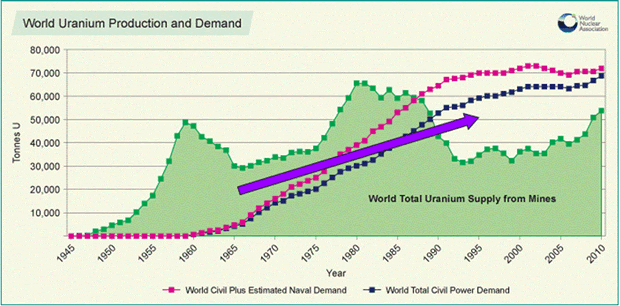
Why was there a bull market in uranium developing, can it survive and overcome the negative fallout from Fukushima-Daiichi? A quick review of nuclear powers fundamentals are in order:
- Coal and natural gas plants emit carbon dioxide emissions and natural gas needs an incredible amount of investment in pipelines and supporting infrastructure
- Operating a 1,000-MW coal plant, for one year, produces 30,000 truckloads of ash that contains large amounts of carcinogens and toxins. Every second, up the smokestack, goes 600 pounds of carbon dioxide and ten pounds of sulfur dioxide
- Extensive use of hydrogen is not practical due to its volatile nature and lack of infrastructure
- Solar, wind and geothermal are all niche suppliers and are untried on a large scale. Geothermal seems to be limited to a few parts of any country and all three alternative means of generating electricity need massive investment in power transmission lines to get the power to where it's needed. All three of these technologies are extremely important and each will successfully contribute, in a small way, to energy independence. But none are, today, capable of supplying base load power
- A 1,000-MW solar plant would cover 129 to 259 square kilometers and use a thousand times the material needed to construct a nuclear plant of the same capacity.
- To equal the output of South Korea's Yongwangs six one-thousand-megawatt nuclear reactors, wind generators would require an area 245 kilometers wide extending from San Francisco to Los Angeles. Solar would require roughly 52 square kilometers of collector area.
- High emissions, a negative energy return and severe environmental costs are associated with ethanol and make its use impractical
- Hydro - going to clean eco-friendly energy isn't accomplished by damming what free-flowing rivers are left
The World Health Organization and other sources attribute about 1 million deaths/year to coal air pollution.
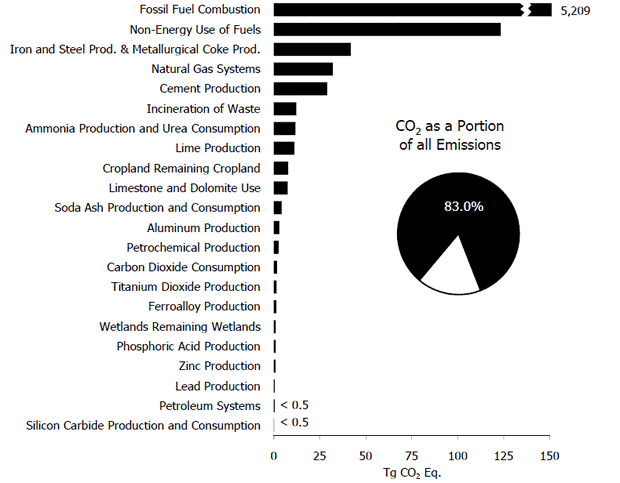
2009 sources of CO2 emissions EPA
The primary greenhouse gas emitted by human activities in the United States is CO2 - 83 percent of total greenhouse gas emissions. Fossil fuel combustion is the largest source of U.S. greenhouse gas emissions and has accounted for approximately 78 percent of emissions since 1990.
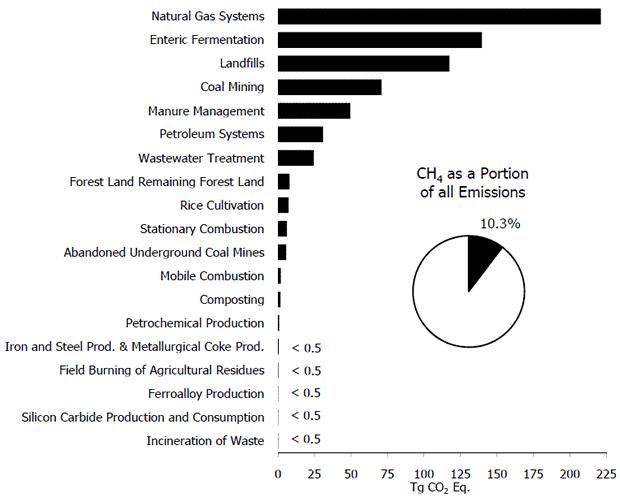
2009 sources of Methane CH4 emissions EPA
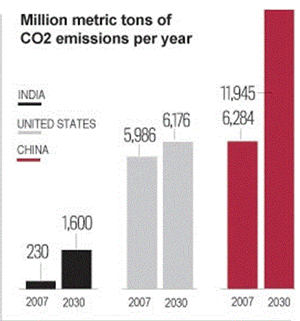 Methane is more than 20 times as effective as CO2 at trapping heat in the atmosphere. Natural gas systems were the largest anthropogenic(refers to greenhouse gas emissions that are a direct result of human activities or are the result of natural processes that have been affected by human activities) source of methane emissions in the United States in 2009.
Methane is more than 20 times as effective as CO2 at trapping heat in the atmosphere. Natural gas systems were the largest anthropogenic(refers to greenhouse gas emissions that are a direct result of human activities or are the result of natural processes that have been affected by human activities) source of methane emissions in the United States in 2009.
In the US electricity generators rely on coal for over half of their total fuel. The Chinese rely on coal for about two-thirds of their total energy production. In the International Energy Outlook 2010 Reference case, world coal consumption increases by 56 percent from 2007 to 2035.
The report "Economic Analysis of Various Options of Electricity Generation - Taking into Account Health and Environmental Effects" by Nils Starfelt Carl and Erik Wikdahl is based on data from the EU ExternE project published in 1999.
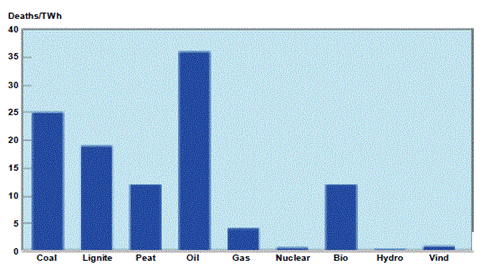
This report describes the health risks associated with electricity production - expressed in terms of number of deaths per trillion watt hours (TWh) - and came to some interesting conclusions regarding the human cost of electricity produced in the European Union:
- Coal, lignite and oil produce more extensive health risks than do other forms of energy
- Hydro power and nuclear power produce health risks that are two orders of magnitude less than those resulting from coal and oil
Reasons to Use Nuclear Energy:
- One pound of yellowcake (U3O8 - the final product of the uranium milling process) has the energy equivalence of 35 barrels of oil. One 7 gram uranium fuel pellet has an energy to electricity equivalent of 17,000 cubic feet of natural gas, 564 liters of oil or 1,780 pounds of coal
- Nuclear power's life-cycle emissions range from 2 to 59 gram-equivalents of carbon dioxide per kilowatt-hour. Only hydropower's range ranked lower at 2 to 48 grams of carbon dioxide-equivalents per kilowatt-hour. Wind came in at 7 to 124 grams and solar photovoltaic at 13 to 731 grams. Emissions from natural gas fired plants ranged from 389 to 511 grams. Coal produces 790 to 1,182 grams of carbon dioxide equivalents per kilowatt hour. International Energy Agency
- Nuclear energy is the only proven technology that can deliver baseload electricity on a large scale, 24 hours a day, 7 days a week, regardless-of-the-weather, without producing carbon dioxide emissions. Nuclear power plants emit no carbon pollution--no carbon monoxide, no sulfur oxides and no nitrogen oxides to the atmosphere.
- Natural gas accounts for 80% of the cost to produce power from an NG power plant. Uranium accounts for 5%-10% of the price of nuclear energy
- Power production cost results when comparing nuclear/gas, nuclear/coal or nuclear/hydro - only coal is cheaper
- Nuclear energy is reliable. Nuclear power plants do not depend on weather conditions to produce electricity nor do they need costly electricity storage options
- One ton of uranium produces more energy than several million tons of coal and oil. Fuel transportation costs are less and there is less impact on our environment from mining or fracking shale gas
- Nuclear power plants require very little space and can be situated close to where their power output is needed
Qulliq Energy Corp. (QEC) operates 27 diesel plants throughout Canada's Nunavut Territory. According to a 2010 QEC report energy costs have risen to about $1 per kilowatt hour in remote communities like Kimmirut and close to 50 cents per kWh in the capital of Nunavut versus an average of 8.5 cents per kWh in cities further south like Calgary and Toronto.
While traditional nuclear plants produce upwards of 1,000 megawatts of electrical power, smaller designs could power everything from remote work camps to larger, off the grid towns:
-
Built in the 1970s by Atomic Energy of Canada Ltd. (AECL), the shoebox-sized SLOWPOKE reactors are only powerful enough to heat a bathtub full of water (20 KW)
-
Toshiba has been developing a 10-megawatt reactor called the 4S. Experts say they are not only economical, but also much safer than conventional designs
"The smaller the reactors are, the easier it is to make them inherently safe because your power densities are much lower and the cooling temperatures involved are much lower, these are power plants you don't need a nuclear PhD to run." said Dr. Jeremy Whitlock, a reactor physicist at Chalk River Laboratories and former president of the Canadian Nuclear Society.
In the interim report Japanese Earthquake and Tsunami: Implications for the UK Nuclear Industrythe UK's Chief Inspector of Nuclear Installations, Dr. Mike Weightman, says the magnitude 9 earthquake and resulting tsunami that hit Japan on March 11, 2011, are "far beyond the most extreme natural events that the U.K. would be expected to experience. The extreme natural events that preceded the accident at Fukushima - the magnitude-9 earthquake and subsequent huge tsunami - are not credible in the UK. We are 1,000 miles from the nearest fault line and we have safeguards in place that protect against even very remote hazards. Our operating and proposed future reactor designs and technology are different to the type at the Fukushima plant."
The Committee on Climate Change (CCC) was set up in 2008 to advise the UK government on climate change issues. Their very first report, recently delivered, stated "It would be possible to decarbonise electricity generation with very significant nuclear deployment... Nuclear generation in particular appears likely to be the most cost-effective form of low-carbon power generation in the 2020s (i.e. before costs of other technologies have fallen), justifying significant investment if safety concerns can be addressed."
Kiev is moving ahead with plans to build two new reactors at the Khmelnytsky power plant. "I believe there is no possible alternative to the use of nuclear energy and only rich countries can afford to discuss the possibility of closing nuclear plants." Ukrainian Prime Minister Mykola Azarov
"Regulators should press ahead with approving construction licenses for new nuclear power plants despite Japan's nuclear crisis." U.S. Energy Secretary Steven Chu, March 15 2011
Uranium Supply and Demand
If the use of fast-breeder reactors becomes widespread more energy could be harvested by reprocessing spent fuel. Thorium reactors are being developed and thorium is many times more plentiful in the earth's crust than uranium. But it will be several decades before these technologies can be adopted in sufficient quantity to impact uranium demand. Also the large upfront capital costs of the pressurized water reactors we've already built means we're committed to the once through uranium fuel cycle for the next 30-40 years.
In March German Chancellor Angela Merkel ordered the country's seven oldest reactors temporarily shut down removing more than 25 percent of its 20,700 megawatts of capacity.
"Germany's recently announced decision to phase out nuclear power (now 23% of electricity supplies) will likely prove costly and undermine industrial competitiveness, as the country shifts to much higher-cost, less reliable base-load electricity sources and becomes more dependent upon imported energy." Patricia Mohr Scotia Bank
Megatons to Megawatts
There is a shortage of mined uranium - our current mine supply deficit is 25% of total yearly demand. We've been covering the deficit with government stockpiles, utility stockpiles and the Megaton to Megawatts Program.
Today utilities stockpiles are pretty much depleted.
Mine production is now primarily supplemented by ex-military material - the Megatons to Megawatts program. The Highly Enriched Uranium (HEU) Purchase Agreement to convert 500 tonnes of HEU to low enriched uranium (LEU) with Russia will expire in 2013 - Russia has said they will not renew it.
RBC Capital Markets analysts Adam Schatzker and H. Fraser Phillips predicted that uranium prices would start to recover in the second half of 2011:
"The fallout from Japan's nuclear crisis will hit global demand for uranium, but it will also negatively affect future supply of the mineral, and the uranium market will remain in deficit from 2011 until 2020...As a result we expect that, at some point in the next 12 to 18 months, utilities will begin to see an increasingly tight long-term contract market to the point where there is all but no supply availability."
Japan has 55 nuclear reactors using 21.3 million pounds (mlbs) of uranium - 12-13% of annual global uranium demand. Japan has shut down 20% - 24% of their reactor fleet which equates to global uranium demand lessening by 4-5mlbs on an annualized basis. According to Bloomberg even if Japan only develops half of its proposed 19 gigawatts of nuclear power this decade, the country, together with China, India, Russia and South Korea, will add a combined 160 gigawatts by 2020.
The four major growth markets for nuclear power are:
- China
- India
- Russia
- South Korea
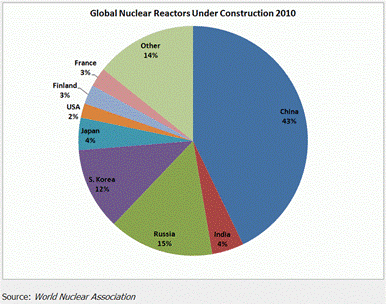
All four countries are expected to continue with previously announced nuclear energy expansion plans.
Out of the 62 reactors currently under construction, 48 - or 77% of the total - are being built in these four markets, another 82 reactors are planned and 210 are proposed for these four markets.
China
"Nuclear is the only energy source that can be used on a mass scale to achieve the nation's goal of developing cleaner, low carbon energy." China's vice-president of the China Nuclear Energy Association, Zhao Chengkun
Currently China has 13 nuclear reactor units in use and another 28 units are under construction. The World Nuclear Association (WNA) says China is planning to construct an additional 187 nuclear reactors. The China Nuclear Energy Association said, May 12th 2010, it will boost atomic capacity as much as eight times by 2020.
Statistics from the WNA show China's annual consumption of uranium will reach 20,000 tons by 2020 - about one third of global output in 2009.
"China would face its most severe electricity shortage since 2004, there could be a national shortage of 30 million kilowatt hours this summer, which would equate to the consumption of three Chongqings (southern city of 31 million)." Xue Jing of the China Electricity Council
The southern province of Guangdong - the most industrialised province in China - has issued warnings about the regions power supply, saying the shortfall could reach 4m kW per hour during May, June and July.
China has banned exports of diesel and the price of thermal coal - which fuels almost 70 per cent of China's power plants - has risen by nearly one fifth since last year. Hydropower generated electricity has fallen after a dry winter in southern China.
Russia
Nuclear power currently accounts for 16 per cent of Russia's electricity generation, and the nation has set a target to raise its share to one-quarter by 2030. Vladimir Putin, Russia's Prime Minister, said his government won't revise its program of building new nuclear reactors following Japan's Fukushima nuclear reactor accident.
"It is impossible to speak about a global energy balance without the nuclear power industry." Mr. Putin said at a meeting of the intergovernmental council of the Eurasian Economic Community (EurAsEC).
Russia would have to build a total of 40 new reactors to fulfill the goal of 25% nuclear supplied electricity- 54 reactors are currently either: under construction 10, planned 14 or proposed 30. The latest Federal Target Program (FTP) envisages a 25-30% nuclear share in electricity supply by 2030, 45-50% in 2050 and 70-80% by the end of the century.
Belarus, Ukraine, Armenia and Turkey have all recently purchased Russian made nuclear power stations. Russia and Hungary also opened talks on the possible participation of Russian companies in a project to modernize Hungary's Paks nuclear power plant. Russia has also signed a new deal to build a nuclear power plant in Bangladesh.
India
India's shortage of fossil fuels (coal provides 68% of the electricity at present, but reserves are limited, gas provides 8%, hydro 14%) is the driving force behind the nuclear investment for electricity - 25% nuclear contribution is foreseen by 2050, when 1094 GWe of base-load capacity is expected to be required.
India's nuclear power generation capacity is currently at 4.7 GW and set to rise to 7.3 GW by the end of March 2012. By 2020, the country hopes to have over 20 GW (20,000 MWe) of nuclear power generating capacity and 63,000 MWe by 2032.
The country has signed a nuclear power deal with the United States and opened up its estimated $150 billion nuclear power market to private reactor builders such as GE and Areva.
India has a 12 percent peak hour power shortfall and roughly 500 million people in India are without electricity. Electricity demand in India is increasing rapidly with 830 billion kilowatt hours (kWh) produced in 2008 - 700 kWh per capita for the year but when transmission losses are counted it resulted in 591 kWh consumption per capita. India's per capita electricity consumption figure is expected to double by 2020 - 6.3% annual growth - and reach 5000-6000 kWh by 2050.
"Our requirement of adding electricity is very high. Over 40 percent of our people still don't have access to electricity." Srikumar Banerjee, chief of India's atomic regulatory body.
India's Atomic Energy Commission said it will increase production 13 fold by 2030, all of the increase fuelled by imported uranium. The Atomic Energy Commission envisages some 600-700 GWe online by 2050.
South Korea
After winning a $20 billion contract to supply four nuclear reactors to the United Arab Emirates (UAE) South Korea is set to become a world leader in exporting nuclear technology.
Nuclear energy is a strategic priority for South Korea and capacity is planned to increase by 56% to 27.3 GWe by 2020, and then to 35 GWe by 2030.
Today 21 reactors provide almost 40% of South Korea's electricity - 11 more South Korean reactors are under construction, on order or planned. South Korea plans to complete 18 nuclear power plants by 2030.
Generation capacity of 72.5 GWe in 2008 is expected to grow to 88 GWe total in 2017 - 26.6 GWe (30%) of this will be nuclear supplying 47% of demand (214 TWh).
After its sale of four reactors to the UAE, the South Korean Ministry of Knowledge Economy said, in January 2010, that it aimed to achieve exports of 80 nuclear power reactors by 2030. South Korea's goal is to achieve a 20% share of the world market - third behind the USA and France/Russia.
Following the UAE sale Korea is marketing to Turkey, Jordan, Romania and Ukraine, as well as South East Asian countries. In addition to exporting reactors, Korea has also entered the $78 billion market for the operation, maintenance and repair of reactors.
Others
Nuclear power is still under serious consideration in many countries which do not currently have it:
- Europe: Italy, Albania, Serbia, Croatia, Portugal, Norway, Poland, Belarus, Estonia, Latvia, Ireland, Turkey
- Middle East and North Africa: Iran, Gulf states including UAE, Saudi Arabia, Qatar & Kuwait, Yemen, Israel, Syria, Jordan, Egypt, Tunisia, Libya, Algeria, Morocco, Sudan - water desalination requirements may be the chief driver for nuclear energy for many in this area
- West, central and southern Africa: Nigeria, Ghana, Senegal, Kenya, Uganda, Namibia.
- South America: Chile, Ecuador, Venezuela
- Central and southern Asia: Azerbaijan, Georgia, Kazakhstan, Mongolia, Bangladesh, Sri Lanka
- SE Asia: Indonesia, Philippines, Vietnam, Thailand, Malaysia, Singapore, Australia, New Zealand
- East Asia: North Korea
South Africa plans to start the process for its nuclear build program next year. The country's first new reactor is expected to come on line by 2023, producing 9,600 MW over twenty years.
Conclusion
According to the International Energy Agency global electricity consumption will rise 75 percent to 35,300 terawatt hours by 2035 from 2008's 20,183 terawatt hours.
If we shut down all the reactors under construction - if we never put another nuclear reactor online - we would still need 25% more uranium than is being mined. But emerging markets are driving growth in nuclear power and a major building boom is underway for nuclear capacity.
Each GWe of increased capacity (enough electricity to power one million homes) will require about 200 tU/yr of extra mine production and each reactor about 400-600 tU for the first fuel load.
The World Nuclear Association (WNA) predicted a 33% increase in uranium demand between 2010 and 2020 - that's a minimum 58% (25% current mined deficit + 33% demand increase) increase needed in mined uranium by 2020.
The U.S. produces 27 percent of the world's nuclear power, has 104 operating nuclear reactors and needs about 50-55 million pounds (Mlb) of uranium per year. But the country produces only 4 Mlb of uranium. The U.S. Nuclear Regulatory Commission, on April 21, renewed the operating licenses for the Palo Verde Nuclear Generating Station in Arizona - the US's largest atomic plant - for an additional 20 years.
The U.S. Department of Energy dedicated a new research facility on May 3, 2011, that will accelerate the advancement of nuclear reactor technology. The Consortium for Advanced Simulation of Light Water Reactors (CASL) will use supercomputers to "study the performance of light water reactors and to develop highly sophisticated modeling that will help accelerate upgrades at existing U.S. nuclear plants."
"Nuclear energy is our nation's largest source of carbon-free power and is an important part of our energy mix moving forward. Work done at this facility will help make our fleet of reactors even safer and more efficient while creating jobs, fueling the economy and saving consumers money on their utility bills." U.S. Secretary of Energy Steven Chu
It seems to this author that uranium supplies are going to get very tight and there will be fierce competition for available material in both the spot and long term markets.
Is a resumption of the Nuclear Renaissance on your radar screen?
If not, maybe it should be.
By Richard (Rick) Mills
If you're interested in learning more about specific lithium juniors and the junior resource market in general please come and visit us at www.aheadoftheherd.com. Membership is free, no credit card or personal information is asked for.
Copyright © 2011 Richard (Rick) Mills - All Rights Reserved
Legal Notice / Disclaimer: This document is not and should not be construed as an offer to sell or the solicitation of an offer to purchase or subscribe for any investment. Richard Mills has based this document on information obtained from sources he believes to be reliable but which has not been independently verified; Richard Mills makes no guarantee, representation or warranty and accepts no responsibility or liability as to its accuracy or completeness. Expressions of opinion are those of Richard Mills only and are subject to change without notice. Richard Mills assumes no warranty, liability or guarantee for the current relevance, correctness or completeness of any information provided within this Report and will not be held liable for the consequence of reliance upon any opinion or statement contained herein or any omission. Furthermore, I, Richard Mills, assume no liability for any direct or indirect loss or damage or, in particular, for lost profit, which you may incur as a result of the use and existence of the information provided within this Report.
© 2005-2022 http://www.MarketOracle.co.uk - The Market Oracle is a FREE Daily Financial Markets Analysis & Forecasting online publication.



